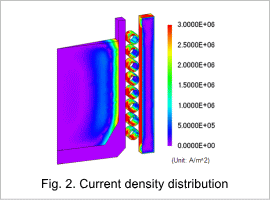*Please prepare a license ID and password for the license administrator.
*It is different from the service for JMAG WEB MEMBER (free membership). Please be careful.
Overview

An induction furnace is an apparatus that uses high-frequency induction heating to melt metal. Running current through the coil surrounding the crucible starts electromagnetic induction phenomena, which generate current in the metal in the crucible. This current produces joule losses in the metal, which are used to heat and melt it. Magnetic yokes are arranged around the coil. The yokes are used as strong components that prevent the Lorentz force generated by the coil from damaging and deforming it. The magnetic yokes also reduce the leakage flux that flows out of the appliance, preventing unintended heating in surrounding structures. Keeping the amount of material used in the magnetic yokes to a minimum makes it possible to reduce the cost of the apparatus.
When evaluating to determine at what temperature does the molten metal in the crucible become uniform, the issue becomes one of what caused the molten metal to become agitated. As parts where heat was generated through induction heating are heated locally a gap in temperature with surrounding metals arises and sparks a convection phenomenon. Applying a large current and using the significant Lorentz force generated in the molten metal enables agitation of the molten metal.
This analysis will evaluate the size of Lorentz force required to agitate and where this is generated.
When evaluating to determine at what temperature does the molten metal in the crucible become uniform, the issue becomes one of what caused the molten metal to become agitated. As parts where heat was generated through induction heating are heated locally a gap in temperature with surrounding metals arises and sparks a convection phenomenon. Applying a large current and using the significant Lorentz force generated in the molten metal enables agitation of the molten metal.
This analysis will evaluate the size of Lorentz force required to agitate and where this is generated.
Magnetic Flux Density Distribution

The magnetic flux density distribution generated in the yokes and the air region is shown in fig. 1. The figure shows that Lorentz force is generated toward the inside of the molten metal.
This enables confirmation of the size and direction of the agitation force.
This enables confirmation of the size and direction of the agitation force.
Current Density Distribution

The current density distribution generated in the molten metal is shown in fig. 2. You can check the depth and size of the eddy current generated inside the molten metal. The Lorentz force distribution generated in the molten metal is shown in fig. 2.
Magnetic Flux Density Distribution

The magnetic flux density distribution generated in the molten metal is shown in fig. 3.
Lorentz Force of Molten Metal

The Lorentz force of the molten metal is shown in Table 1. We learned the force of the axis direction component Z is small and radial direction component R is large.


